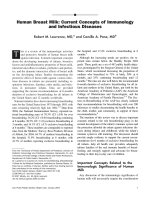concepts of life time fitness
Bạn đang xem bản rút gọn của tài liệu. Xem và tải ngay bản đầy đủ của tài liệu tại đây (24.12 KB, 2 trang )
Concepts of Lifetime Fitness September 1, 1997 Homeostasis is the
state of equilibrium in which the internal environment of the human body
remains relatively constant. Two excellent examples of homeostasis are
how the body maintains a constant temperature and blood pressure
during strenuous physical activity or exercise. Although there are many
other activities in the body that display homeostasis, I will only discuss
these two. Temperature in the human body is usually kept at
approximately 37 degrees Celsius. To maintain such a strict
temperature, the body has a few functions to combat the outside
elements. People cannot make themselves cold as readily as make
themselves hot, however I will mention both homeostasis functions.
When the external temperature decreases, a portion of the brain called
the hypothalamus detects the drop by means of the blood. To
compensate, the brain sends chemical and electrical impulses to the
muscles. These impulses tell the muscles to begin to contract and relax
at very high intervals. This is commonly known as shivering. The
production of Adenosine Triphosphate or ATP in the mitochondria of the
muscles produces heat. If the body temperature does not rise
immediately after this, then a second function begins. The brain will signal
the blood vessels near the skin to constrict or narrow in diameter. This
occurs so the heat deep in the muscles is conserved. Since the vessels
are now smaller in diameter, less blood is needed to fill them. Since less
blood is needed through the vessels, the heart begins to slow. If the body
remains in this slowed state, hypothermia could result. Hypothermia is
the condition in which metabolic processes are inhibited. The medical
world has taken advantage of this by inducing hypothermia in patients
that are undergoing organ transplants. To fight temperatures higher than
normal, as in exercise or on hot days, the body reacts in the opposite way
than with cold. Again, the hypothalamus detects the change of
temperature in the blood. The brain signals blood vessels not to
constrict, but to dilate. This increases the diameter of the vessels, and
results in the need for more blood. Since more blood is needed to fill the
vessels, the heart pumps faster and that causes respiration to increase.
The increased respiration will make the body exhale some of the internal
heat, like placing a fan in a window to cool a room. The blood vessels
are dilated so the heat deep in the muscles is easily released. Another
commonly known mechanism to fight heat is sweating. Sweat glands
found throughout the body are stimulated by the hypothalamus to excrete
sweat and when the sweat evaporates, the skin is cooled. If the body is
not cooled by the time all of the internal water supply is used, it could go
into hypothermia. This is when the body becomes dehydrated and
proteins begin to denature. Hypothermia can result in certain death if the
water supply is not immediately replenished. Some advantages to these
mechanisms are the cleansing effect of sweating and weight loss. Sweat,
when excreted, removes waste materials such as bacteria and water. Fat
material, during exercise, is actually "eaten" by the body thus reducing
overall weight. The second example of homeostasis is blood pressure
regulation. When the hydrostatic pressure of blood is above normal,
pressure sensors in the blood vessels tell the brain through chemical
means. The brain will then stimulate the heart to contract or beat in
slower intervals. This will cause less blood to enter the blood vessels and
that will lower the hydrostatic pressure. If the pressure is lower than
normal, the exact opposite happens. The sensors in the vessels tell the
brain and the brain will then make the heart beat faster so more blood
enters the vessels and the pressure is raised. The body uses many
mechanisms to regulate temperature and blood pressure. Be it stimuli to
the heart from the brain or messages from the blood, the body maintains
its internal environment through a process called homeostasis.









